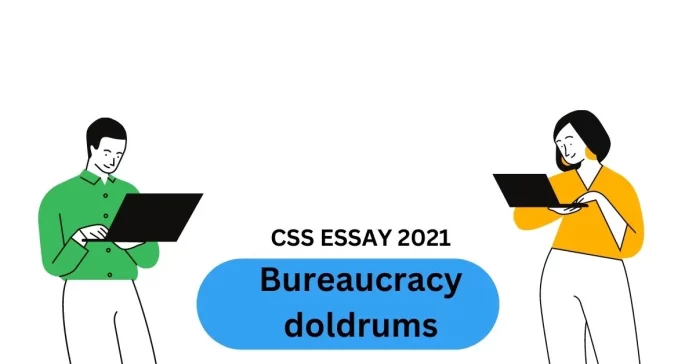Thesis statement
Bureaucracy, while a necessary component of modern governance, often encounters obstacles that hinder efficiency, innovation, and responsiveness, leading to what is commonly known as “bureaucracy doldrums.”
Introduction
Bureaucracy, while a necessary component of modern governance, often encounters obstacles that hinder efficiency, innovation, and responsiveness, leading to what is commonly known as “bureaucracy doldrums.” In this essay we aim to delve into the complexities of bureaucracy, identify the challenges it faces, and explore potential solutions to overcome these hurdles. By understanding the underlying issues and promoting adaptive practices, we can strive to create more efficient and effective administrative systems.
Exposition: Understanding Bureaucracy and Its Role
A. Defining Bureaucracy
Bureaucracy refers to a hierarchical system of administration that governs organizations and governments. It entails a formalized structure, standardized procedures, and a clear chain of command to ensure accountability and efficiency.
B. The Importance of Bureaucracy
Bureaucracy plays a crucial role in organizational and governmental structures. It provides stability, consistency, and adherence to established rules and regulations. Bureaucratic systems help ensure the fair and equitable treatment of individuals, promote transparency, and uphold the rule of law.
Argumentation: Challenges Faced by Bureaucracy
A. Excessive Red Tape and Bureaucratic Rigidity
One of the key challenges is the presence of excessive red tape and bureaucratic rigidity. Cumbersome procedures, layers of approvals, and complex regulations slow down decision-making processes and hinder efficiency. This rigidity can stifle innovation and impede responsiveness to changing circumstances.
B. Lack of Flexibility and Adaptability
Bureaucratic systems often struggle with adapting to new challenges and emerging trends. The hierarchical nature and strict adherence to established protocols make it difficult to embrace change and respond quickly to evolving needs. This lack of flexibility can result in missed opportunities and the inability to address complex problems effectively.
C. Organizational Silos and Communication Barriers
Bureaucracies are prone to the formation of organizational silos, where different departments or units operate independently, leading to communication barriers and limited collaboration. Silos impede the flow of information, hinder coordination, and create inefficiencies in decision-making processes.
Description: Real-life Examples of Bureaucracy Doldrums
A. Government Bureaucracy
Government bureaucracies often face challenges in delivering public services efficiently. Lengthy approval processes, bureaucratic bottlenecks, and excessive paperwork can lead to delays and frustrations for citizens. For instance, obtaining permits or licenses may involve navigating complex procedures, leading to administrative backlogs and inefficiencies.
B. Corporate Bureaucracy
Large corporations can also experience bureaucracy doldrums. Layers of management, rigid hierarchical structures, and excessive reporting requirements can hinder innovation and agility. Decision-making may become slow and bureaucratic, impeding the organization’s ability to respond to market changes and customer needs.
C. Nonprofit and International Bureaucracy
Nonprofit organizations and international institutions are not immune to bureaucracy doldrums either. Stringent regulations, complex reporting requirements, and limited flexibility can impede their mission fulfillment. Resources may be allocated inefficiently, and responsiveness to evolving social issues can be hindered.
Narration: Overcoming Bureaucracy Doldrums
A. Streamlining Processes and Reducing Red Tape
To address excessive red tape, bureaucracy should focus on streamlining processes and eliminating unnecessary regulations. Simplifying procedures, digitizing paperwork, and leveraging technology can help expedite administrative tasks and reduce bureaucratic burdens.
B. Cultivating Flexibility and Innovation
Bureaucratic systems need to embrace flexibility and encourage innovation. This involves creating a culture that values new ideas, encourages experimentation, and rewards risk-taking. Empowering employees and providing them with the necessary training and resources can foster a more adaptive and innovative environment.
C. Enhancing Communication and Collaboration
Breaking down silos and improving communication is crucial in overcoming bureaucracy doldrums. Establishing cross-functional teams, encouraging information sharing, and promoting collaborative decision-making can enhance coordination and effectiveness within bureaucratic systems.
Conclusion
Bureaucracy doldrums pose significant challenges to administrative systems. However, by recognizing the obstacles and implementing adaptive practices, we can navigate these challenges effectively. Streamlining processes, fostering flexibility and innovation, and enhancing communication and collaboration are key steps toward creating more efficient and responsive bureaucratic systems. By doing so, we can strive to overcome bureaucracy doldrums and create administrative structures that better serve the needs of individuals, organizations, and society as a whole.











